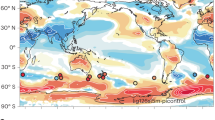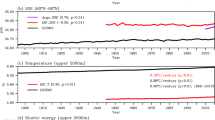Abstract
A global coupled ocean–atmosphere model of intermediate complexity is used to simulate the equilibrium climate of both today and the Last Glacial Maximum, around 21,000 years ago. The model successfully predicts the atmospheric and oceanic circulations, temperature distribution, hydrological cycle and sea-ice cover of both periods without using ‘flux adjustments’. Changes in oceanic circulation, particularly in the Atlantic Ocean, play an important role in glacial cooling.
This is a preview of subscription content, access via your institution
Access options
Subscribe to this journal
Receive 51 print issues and online access
$199.00 per year
only $3.90 per issue
Buy this article
- Purchase on Springer Link
- Instant access to full article PDF
Prices may be subject to local taxes which are calculated during checkout







Similar content being viewed by others
References
CLIMAP Project Members. Seasonal reconstruction of the Earth's surface at the last glacial maximum. (Map Chart Ser. MC-36, Geol. Soc. Am., Boulder, Geol. Soc. Am.(1981).
Joussaume, S. & Taylor, K. E. in Proc. 1st Int. AMIP Scientific Conf., Monterey 425–430 (World Climate Research Project, 1995.
Webb, R. S., Rind, D. H., Lehman, S. J., Healy, R. J. & Sigman, D. Influence of ocean heat transport on the climate of the last glacial maximum. Nature 385, 695–699 (1997).
Fichefet, T., Hovine, S. & Duplessy, J. C. Amodel study of the Atlantic thermohaline circulation during the last glacial maximum. Nature 372, 252–255 (1994).
Seidov, D., Sarnthein, M., Stattegger, K., Prien, R. & Weinelt, M. North Atlantic ocean circulation during the last glacial maximum and subsequent meltwater event—a numerical model. J. Geophys. Res. C 7, 16305–16332 (1996).
Winguth, A. M. E., Maier-Reimer, E., Mikolajewicz, U. & Deplessy, J.-C. On the sensitivity of an ocean general circulation model to glacial boundary conditions. Paleoceanography(submitted).
Boyle, E. A. & Keigwin, L. D. Deep circulation of the North Atlantic over the last 200,000 years: Geochemical evidence. Science 218, 784–787 (1982).
Curry, W. B., Duplessy, J. C., Labeyrie, L. D. & Shackleton, N. J. Changes in the distribution of δ13C of deep water ΣCO2between the last glaciation and the Holocene. Paleoceanography 3, 317–341 (1988).
Sarnthein, M.et al. Variations in Atlantic surface paleoceanography, 50–80N: A time slice record of the last 30,000 years. Paleoceanography 10, 1063–1094 (1995).
Petoukhov, V.et al. CLIMBER-2: A climate system model of intermediate complexity. Clim. Dyn.(submitted).
Petoukhov, V. K. & Ganopolski, A. V. A Set of Climate Models for Integrated Modelling of Climate Change Impacts 1–96 (IIASA, Laxenburg, 1994).
Stocker, T. F., Wright, D. G. & Mysak, L. A. Azonally averaged, coupled ocean–atmosphere model for paleoclimate studies. J. Clim. 5, 773–797 (1992).
Rahmstorf, S. Bifurcations of the Atlantic thermohaline circulation in response to changes in the hydrological cycle. Nature 378, 145–149 (1995).
Gleckler, P. J.et al. Cloud-radiative effects on implied oceanic energy transports as simulated by atmospheric general circulation models. Geophys. Res. Lett. 22, 791–794 (1995).
Peltier, W. R. Ice age paleotopography. Science 265, 195–201 (1994).
Schmitz, W. J. On the interbasin scale thermohaline circulation. Rev. Geophys. 33, 151–173 (1995).
Macdonald, A. & Wunsch, C. An estimate of global ocean circulation and heat fluxes. Nature 382, 436–439 (1996).
Toggweiler, J. R. & Samuels, B. in The Global Carbon Cycle (ed. Heimann, M.) 333–366 (Springer, Berlin, 1993).
Döös, K. The Deacon cell and the other meridional cells of the Southern Ocean. J. Phys. Oceanogr. 24, 429–442 (1994).
Rahmstorf, S. On the freshwater forcing and transport of the Atlantic thermohaline circulation. Clin. Dyn. 12, 799–811 (1996).
Levitus, S., Burgett, R. & Boyer, T. World Ocean Atlas 1994 Vol. 3, Salinity 1–150 (US Govt Printing Office, Washington DC, 1994).
Hall, M. M. & Bryden, H. L. Direct estimates and mechanisms of ocean heat transport. Deep-Sea Res. 29, 339–359 (1982).
Stommel, H. Asymmetry of interoceanic freshwater and heat fluxes. Proc. Natl Acad. Sci. USA 77, 2377–2381 (1980).
Manage, S. & Stouffer, R. J. Two stable equilibria of a coupled ocean–atmosphere model. J. Clim. 1, 841–866 (1988).
Houghton, J. T.et al. (eds) Climate Change 1995—The Science of Climate Change (Cambridge Univ. Press, 1996).
Street-Perrot, F. A. & Harrison, S. P. in Paleoclimate Analysis and Modeling (ed. Hecht, A. D.) 291–340 (Wiley, New York, 1985).
Herron, M. M. & Langway, C. C. in Greenland Ice Core: Geophysics, Geochemistry, and the Environment (eds Langway, C. C., Oeschger, H. & Dansgaard, W.) 77–84 (Am. Geophys. Union, Washington DC, 1985).
Winkler, M. G. & Wang, P. K. in Global Climates since the Last Glacial Maximum (ed. Wright, H. E.) 221–264 (Univ. Minnesota Press, Minneapolis, 1993).
Hooghiemstra, H., Bechler, A. & Beug, H.-J. Isopollen maps for 18,000 years B.P. of the Atlantic offshore of Northwest Africa: Evidence for paleowind circulation. Paleoceanography 2, 561–582 (1987).
Sarnthein, M.et al. Changes in east Atlantic deepwater circulation over the last 30,000 years: Eight time slice reconstructions. Paleoceanography 9, 209–267 (1994).
Yu, E.-F., Francois, R. & Bacon, M. P. Similar rates of modern and last-glacial ocean thermohaline circulation inferred from radiochemical data. Nature 379, 689–694 (1996).
Lynch-Stieglitz, J. & Fairbanks, R. G. Aconservative tracer for glacial ocean circulation from carbon isotope and palaeonutrient measurements in benthic foraminifera. Nature 369, 308–310 (1994).
Rahmstorf, S. Rapid climate transitions in a coupled ocean–atmosphere model. Nature 372, 82–85 (1994).
Beckmann, A. & Döscher, R. Amethod for improved representation of dense water spreading over topography in geopotential-coordinate models. J. Phys. Oceanogr. 27, 581–591 (1997).
Cubasch, U.et al. Aclimate change simulation starting from 1935. Clim. Dyn. 11, 71–84 (1995).
Manabe, S. & Stouffer, R. J. Multiple-century response of a coupled ocean–atmosphere model to an increase of atmospheric carbon dioxide. J. Clim. 7, 5–23 (1994).
Rahmstorf, S. Risk of sea-change in the Atlantic. Nature 388, 825–826 (1997).
Stute, M.et al. Cooling of tropical Brazil (5 °C) during the last glacial maximum. Science 269, 379–383 (1995).
Thompson, L. G.et al. Late glacial stage and holocene tropical ice core records from Huascaran, Peru. Science 269, 46–50 (1995).
Beck, J. W., Récy, J., Taylor, F., Edwards, R. L. & Cabioch, G. Abrupt changes in early holocene tropical sea surface temperature derived from coral records. Nature 385, 705–707 (1997).
Guilderson, T. P., Fairbanks, R. G. & Rubenstone, J. L. Tropical temperature variations since 20,000 years ago: Modulating interhemispheric climate change. Science 263, 663–665 (1994).
Broecker, W. S. Oxygen isotope constraints on surface ocean temperatures. Quat. Res. 26, 121–134 (1986).
Peyron, O.et al. Climatic reconstruction in Europe from pollen data, 18,000 years before present. Quat. Res.(in the press).
Guiot, J., Pons, A., de Beaulieu, J. L. & Reille, M. A140,000 year climatic reconstruction from two European records. Nature 338, 309–313 (1989).
Jäger, L. Monatskarten des Niederschlags für die ganze Erde, Ber. Deutschen Wetterdienstes No. 139, 1–38 (1976).
Hellerman, S. & Rosenstein, M. Normal monthly wind stress over the world ocean with error estimates. J. Phys. Oceanogr. 13, 1093–1104 (1983).
Acknowledgements
S.R. and M.C. acknowledge discussions with S. Joussaume, A. Broccoli and others at the European Science Foundation's Research Conference on Paleoclimate Modelling and Analysis, in Castelvecchio Pascoli. We received comments on the manuscript from E. Bard; D. Smart critically read the manuscript. This work was supported by the European Union's Environment and Climate programme.
Author information
Authors and Affiliations
Corresponding author
Rights and permissions
About this article
Cite this article
Ganopolski, A., Rahmstorf, S., Petoukhov, V. et al. Simulation of modern and glacial climates with a coupled global model of intermediate complexity. Nature 391, 351–356 (1998). https://doi.org/10.1038/34839
Received:
Accepted:
Issue Date:
DOI: https://doi.org/10.1038/34839
This article is cited by
-
Ocean sensitivity to freshwater
Nature Climate Change (2022)
-
Redefining the timing of Tongul glacial stage in the Suru valley, NW Himalaya, India: New insights from luminescence dating
Journal of Earth System Science (2020)
-
Time-scale and state dependence of the carbon-cycle feedback to climate
Climate Dynamics (2014)
-
Assessing the sensitivity of the North Atlantic Ocean circulation to freshwater perturbation in various glacial climate states
Climate Dynamics (2011)
-
Constraining ocean diffusivity from the 8.2 ka event
Climate Dynamics (2010)
Comments
By submitting a comment you agree to abide by our Terms and Community Guidelines. If you find something abusive or that does not comply with our terms or guidelines please flag it as inappropriate.



